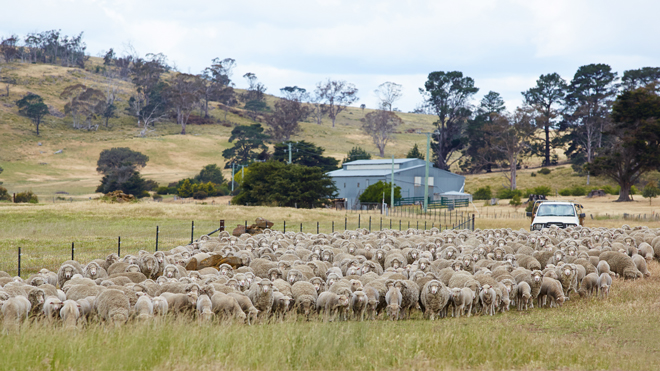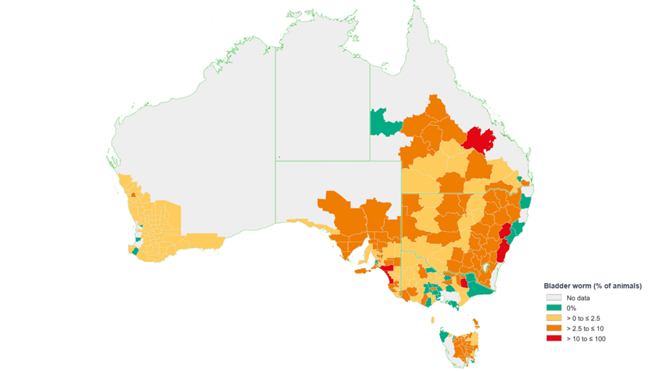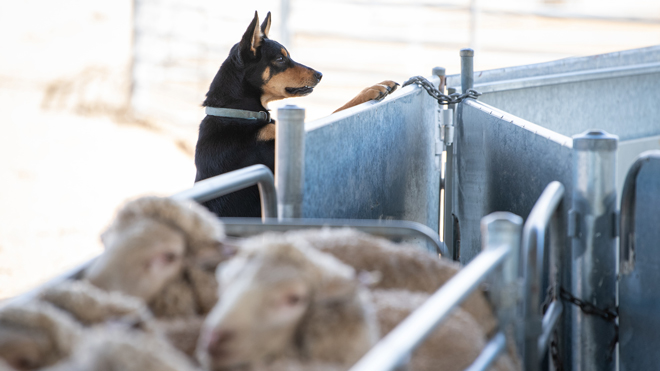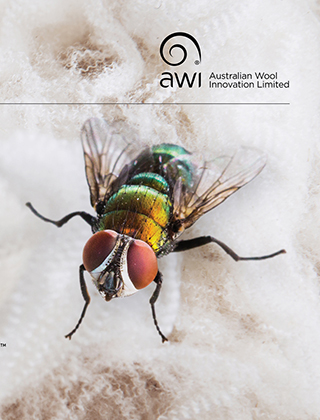National sheep flock proven to be healthy

An annual sheep industry project that last year monitored nearly 10 million Australian sheep found a low incidence of disease, demonstrating the excellent animal health and welfare practices in the Australian sheep industry. Continued vigilance by sheep and wool producers will help ensure that this situation continues.
The National Sheep Health Monitoring Project (NSHMP) commenced in 2007 to monitor lines of sheep in abattoirs for animal health conditions that might reduce productivity in the sheep value chain or impact market access.
In 2022/23, the monitoring occurred in 10 abattoirs. Meat inspectors inspected 9,822,174 sheep including lambs (an increase of more than two million animals compared to the previous year) in 42,756 lines from 10,247 Property Identification Codes (PICs) for 19 animal health conditions.
The results of the NSHMP allow producers to adapt their management practices to address the animal health conditions most relevant to their local area. Producers can also access data specific to their own lines of sheep via Meat & Livestock Australia’s myFeedback.
Sheep monitored during the project in 2022/23 were sourced from all Australian states. Of the direct lines of sheep, 41% were from NSW, 21% from South Australia, 16% from Western Australia, 9% from Victoria and 7% from both Queensland and Tasmania.
The NSHMP 2022/23 Annual Report provides an analysis of the data from the project for 14 of the 19 monitored conditions, thus providing a snapshot of the health of a significant proportion of the Australian sheep flock. The remaining five health conditions (cirrhosis, dog bites, fever/septicaemia, hydatids, rib fractures) had insignificant levels of incidence.
The analysis shows that there is a very low incidence of disease in inspected sheep – see Table 1 below.
Table 1: National percentage of sheep affected by each condition in 2022-2023
|
Condition |
2022/23 % sheep affected |
|
Bladder worm |
2.9 |
|
Pleurisy |
1.8 |
|
Sheep measles |
1.4 |
|
Nephritis |
1.3 |
|
Vaccination lesions |
1.2 |
|
Grass seed |
1.1 |
|
Cheesy gland |
1.0 |
|
Liver fluke |
0.9 |
|
Lungworm |
0.9 |
|
Arthritis |
0.8 |
|
Pneumonia |
0.5 |
|
Bruising |
0.4 |
|
Knotty gut |
0.3 |
|
Sarcocystosis |
0.2 |
For each of the 14 health conditions, the NSHMP Annual Report provides details of:
- the number of sheep in Australia inspected and affected during the past three years
- the percentage of PICs inspected in each state that had at least one affected animal
- the percentage of animals inspected in each state that were affected
- a map showing the percentage of sheep affected in each local government area – see the example below, for bladder worm.
The NSHMP is run by Animal Health Australia (AHA) with the support of sheep industry organisations Sheep Producers Australia and WoolProducers Australia.
AWI Program Manager, Animal Wellbeing and Industry Resilience, Carolina Diaz, who is a member of the NSHMP Steering Committee, says the project has generated comprehensive data that provides a good indication of the excellent animal health status of the Australian flock.
“While governments, industry groups and processors use this information to provide solid evidence to demonstrate the high quality of Australian sheepmeat and to support market access, it also provides further evidence to a wider audience that Australian sheep and wool producers are committed to exceptionally high standards of animal health and welfare,” Carolina said.
“The report is also useful for producers, animal health advisors and state departments of agriculture to track if there are any adverse health conditions emerging in their region so that they can fine tune their animal health programs and address the issues swiftly.
“Although still at low levels, the health conditions that recorded the highest levels of incidence during 2022/23 were bladder worm, pleurisy and sheep measles.”
See below for advice on their on-farm management and prevention.
“The incidence of cheesy gland has decreased from 2021/22. But woolgrowers in particular should look out for the disease in their sheep because it is associated with a decrease in wool production, wool contamination and chronic infection causes ill thrift, emaciation and can affect reproductive performance,” Carolina said.
“With the official declaration of El Niño by the Bureau of Meteorology, it’s possible that we may see a shift in the prevalence of some conditions, especially those that were exacerbated by high rainfall such as grass seed lesions and some internal parasites, such as liver fluke.”
Bladder worm and sheep measles
Bladder worm has now been the top condition for three years in a row and was most common in NSW, where 4.5% of inspected sheep had the condition. It was also observed quite extensively in Tasmania, with 71% of participating properties having at least one affected animal during 2022-23.
Bladder worm is caused by infective cysts from the dog tapeworm Taenia hydatigena which are found in the sheep’s liver and abdominal cavities. Similarly, sheep measles are infective cysts caused by the dog tapeworm Taenia ovis and are found in the muscles of sheep. Most losses to profit are seen at the abattoir due to carcass trimming and offal condemnation, with higher levels of sheep measles likely to lead to full condemns and significant losses to growers as well.
Figure 1: Percentage of sheep affected by bladder worm in each Local Government Area in 2022-2023

On-farm management: There is no treatment for bladder worm and sheep measles, therefore prevention is the best way to manage this condition. The dog tapeworm lifecycle must be disrupted by ensuring all farm and house dogs are wormed monthly with a wormer containing the active ingredient praziquantel, which kills these tapeworms. Furthermore, you can prevent dogs from becoming infected by restricting their access to sheep carcases and raw sheep meat, therefore avoiding the ingestion of infective cysts.

Regular monthly tape worming and removing sheep meat and offal from the diet of farm dogs can control bladder worms in sheep. PHOTO: Stuart Walmsley
Pleurisy
The occurrence of pleurisy has increased during the past three years and is a resulting condition of severe pneumonia where the infection has extended to the outer layer of the lung, known as the pleura. This can cause parts of the lung to adhere to the chest wall, leading to costly trimmings at the abattoir and welfare implications for affected sheep.
On-farm management: Reducing the occurrence of pleurisy requires the effective management of pneumonia in sheep, which includes preventing exposure to irritants within their environment. Excessively dusty and dry conditions, inhalation of drenches and dips as well as stress can all increase the risk of respiratory infections in sheep. Consider reducing the time sheep spend in yards during dry and windy conditions, preventing overcrowding, and taking your time when driving them back to their paddocks. If levels of pneumonia/pleurisy detected are high, it may be worthwhile testing sheep to determine which pathogens are causing the pneumonia (talk to your veterinarian about this).
More information: The NSHMP Annual Report is available at www.animalhealthaustralia.com.au/nshmp

This article appeared in the March 2024 edition of AWI’s Beyond the Bale magazine. Reproduction of the article is encouraged.














